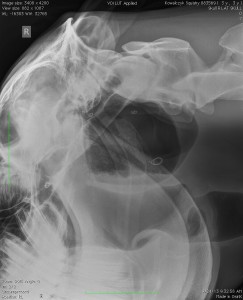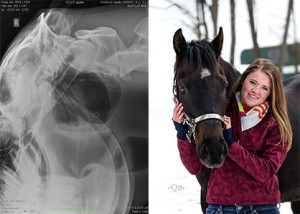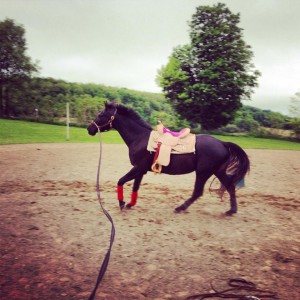Incredible Recovery From Less Than a .5% Chance of Survival
By: Brittany Bevis
Imagine being told that your horse has contracted a disease so rare that only one in 25 million horses will be affected. Then, you receive the news that less than .5% will survive after the first episode, and 50% have lingering issues making it difficult to resume a normal life. That’s the scenario Emily Kowalczyk faced last September when her 4-year-old Quarter Horse gelding was diagnosed with guttural pouch mycosis.
What first began as an innocent nosebleed, that was thought to be the result of a sinus infection, quickly turned deadly the next day when Kowalcyzk discovered her horse was gushing large amounts of blood from his nostrils.
“It happened on September 22nd, which was a Sunday,” she says. “My horse had a very small trickle of blood that came out of his nose. I was clearly concerned, so I called the barn’s primary vet, since my vet was closed on weekends. She told me it was probably his sinus infection breaking and his nose was dry. If anymore blood came out, I should schedule a scope for the next morning. I went ahead and scheduled a scope for the next morning, regardless.”
“At 9:30 on September 23rd, my horse started gushing blood as our vet was on the way to scope. She told me, from the car, that she had a feeling she knew what it was, but she needed to scope to be positive. By the time she got there, we got the blood to subside from cold packing his neck area.”
Kowalcyzk’s vet, Dr. Liz Fish, scoped “Squish” and confirmed that he did in fact have guttural pouch mycosis. The next decision Kowalcyzk faced was to schedule emergency surgery or consider euthanization.
“We had our vet call Cornell University to schedule an emergency surgery,” she says. “She sedated him a little to slow his heart rate to prevent another bleed. He made the two hour trailer ride and started to bleed once we got to Cornell.”
“[This type of] guttural pouch mycosis, from what I was told by all four vets (three at Cornell and Dr. Fish), is rare to the point where they think one in twenty five million will get it. Less than .5% will live after the first bleed. 50% have dysphasia issues as a result of the infection, making it difficult for them to return to a normal show horse life or even a working life.”

An x-ray of Squish’s guttural pouch where four coils were inserted to block blood flow to his carotid artery. Photo provided by Emily Kowalcyzk.
For a brief tutorial about guttural pouch mycosis, the University of Florida’s Large Animal Health Veterinary website is an excellent resource. By definition, the guttural pouches are sacs of air that are located on either side of a horse’s head and are positioned below the ears. Because the pouches are lined with an extremely thin membrane, major arteries and cranial nerves located nearby can sustain extreme damage if the pouches become infected.
A more common disease, guttural pouch empyema, is caused by a bacterial infection that can be secondary to strangles. The difference with guttural pouch mycosis, and the reason it is so rare, is because infection is caused by a fungus. Because no pus accumulates, horses may appear normal until they suddenly exhibit severe hemorrhage or nerve damage (UF College of Veterinary Medicine, 2014).
Incredibly, Squish made it through surgery and is making a full recovery.
“My horse has four coils that will remain in his guttural pouch blocking the blood flow off to his carotid artery, where the infection was attacking,” she says. “He has since lost his vision in his right eye and will never regain it due to the change in blood flow. However, he doesn’t act like he’s half blind and has made a full recovery otherwise.”
“There is still a lot to learn about this infection. The surgery has only recently been perfected. The infection is very rare but he pulled through by a slim miracle. I wanted to share his story to educate more people on this rare and very scary infection. Maybe others have had their horses die for unexpected reasons that could have been due to this. I would like to prevent other horses from getting it but also show that there’s hope and these horses can have a show career after recovering.”
Kowalcyzk and Squish plan on making a return to the show pen at the ESQHA Fall Show. Although Squish has made an amazing recovery, some changes to his training regime were necessary.
“We are getting him used to tracking the second direction without being able to see out of that right eye,” she says. “He’s figuring out his balance without knowing what’s to the inside of him.”
We wish Kowalcyzk and Squish the very best of luck with recovery and return to the show pen!
*Note: This article is simply to be used for informative purposes and is in no way intended to replace the advice or knowledge of a veterinarian.













